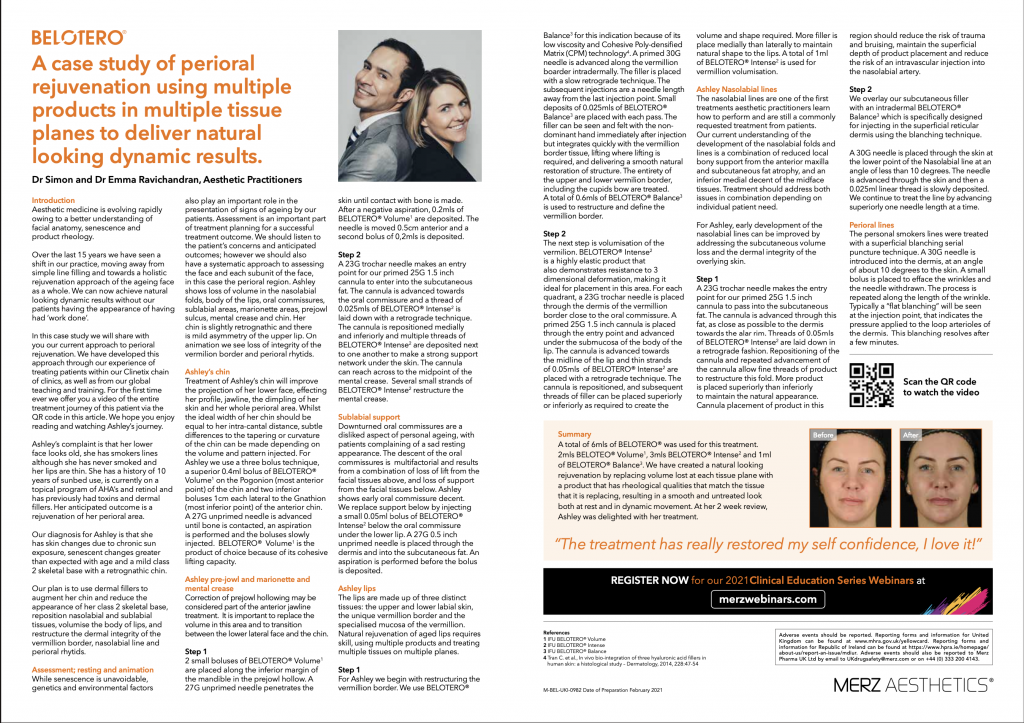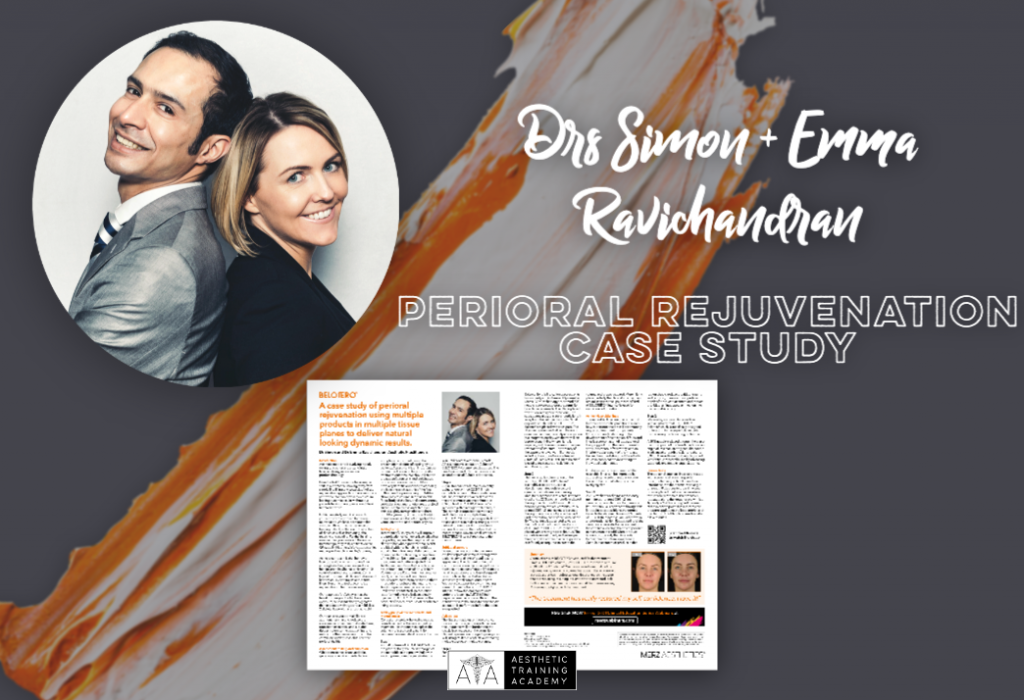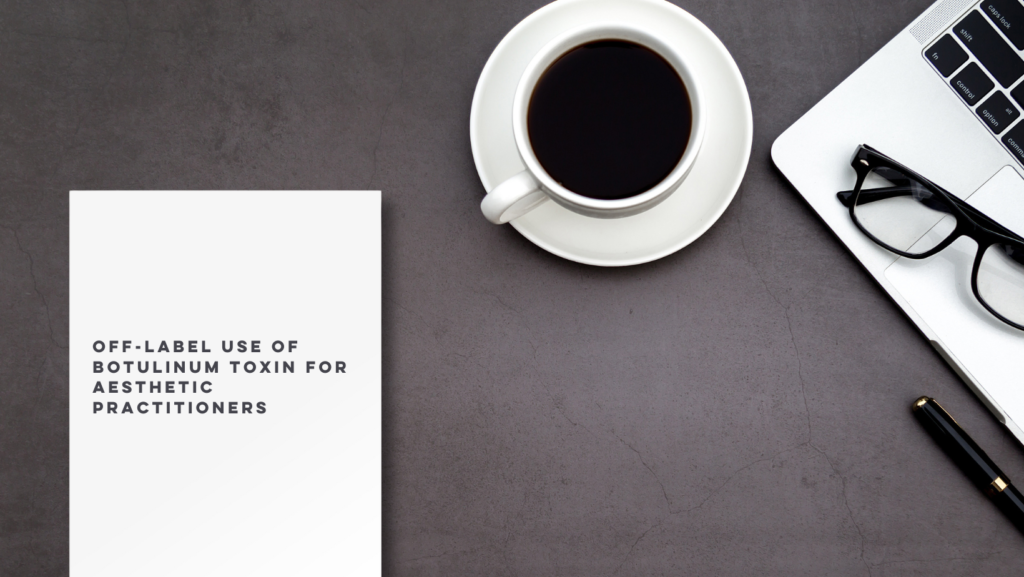Aesthetic Training Academy Directors Drs Simon & Emma Ravichandran featured in this month’s Aesthetics Journal discussing a case study perioral rejuvenation using multiple products to deliver natural looking dynamic results.
 BELOTERO® – A case study of perioral rejuvenation using multiple products in multiple tissue planes to deliver natural looking dynamic results.
BELOTERO® – A case study of perioral rejuvenation using multiple products in multiple tissue planes to deliver natural looking dynamic results.
Dr Simon and Dr Emma Ravichandran, Aesthetic Practitioners
Introduction
Aesthetic medicine is evolving rapidly owing to a better understanding of facial anatomy, senescence and product rheology.
Over the last 15 years we have seen a shift in our practice, moving away from simple line filling and towards a holistic rejuvenation approach of the ageing face as a whole. We can now achieve natural looking dynamic results without our patients having the appearance of having had ‘work done’.
In this case study we will share with you our current approach to perioral rejuvenation. We have developed this approach through our experience of treating patients within our Clinetix chain of clinics, as well as from our global teaching and training. For the first time ever we offer you a video of the entire treatment journey of this patient via the QR code in this article. We hope you enjoy reading and watching Ashley’s journey.
Ashley’s complaint is that her lowerface looks old, she has smokers lines although she has never smoked and her lips are thin. She has a history of 10 years of sunbed use, is currently on a topical program of AHA’s and retinol and has previously had toxins and dermal fillers. Her anticipated outcome is a rejuvenation of her perioral area.
Our diagnosis for Ashley is that she has skin changes due to chronic sun exposure, senescent changes greater than expected with age and a mild class 2 skeletal base with a retrognathic chin.
Our plan is to use dermal fillers to augment her chin and reduce the appearance of her class 2 skeletal base, reposition nasolabial and sublabial tissues, volumise the body of lips, and restructure the dermal integrity of the vermillion border, nasolabial line and perioral rhytids.
Assessment; resting and animation
While senescence is unavoidable, genetics and environmental factors also play an important role in the presentation of signs of ageing by our patients. Assessment is an important part of treatment planning for a successful treatment outcome. We should listen to the patient’s concerns and anticipated outcomes; however we should also have a systematic approach to assessing the face and each subunit of the face, in this case the perioral region. Ashley shows loss of volume in the nasolabial folds, body of the lips, oral commissures, sublabial areas, marionette areas, prejowl sulcus, mental crease and chin. Her chin is slightly retrognathic and thereis mild asymmetry of the upper lip. On animation we see loss of integrity of the vermilion border and perioral rhytids.
Ashley’s chin
Treatment of Ashley’s chin will improve the projection of her lower face, effecting her profile, jawline, the dimpling of her skin and her whole perioral area. Whilst the ideal width of her chin should be equal to her intra-cantal distance, subtle differences to the tapering or curvature of the chin can be made depending on the volume and pattern injected. For Ashley we use a three bolus technique, a superior 0.4ml bolus of BELOTERO® Volume1 on the Pogonion (most anterior point) of the chin and two inferior boluses 1cm each lateral to the Gnathion (most inferior point) of the anterior chin. A 27G unprimed needle is advanced until bone is contacted, an aspiration is performed and the boluses slowly injected. BELOTERO® Volume1 is the product of choice because of its cohesive lifting capacity.
Ashley’s pre-jowl and marionette and mental crease
Correction of prejowl hollowing may be considered part of the anterior jawline treatment. It is important to replace the volume in this area and to transition between the lower lateral face and the chin.
Step 1
2 small boluses of BELOTERO® Volume1 are placed along the inferior margin of the mandible in the prejowl hollow. A 27G unprimed needle penetrates the skin until contact with bone is made. After a negative aspiration, 0.2mls of BELOTERO® Volume1 are deposited. The needle is moved 0.5cm anterior and a second bolus of 0,2mls is deposited.
Step 2
A 23G trochar needle makes an entry point for our primed 25G 1.5 inch cannula to enter into the subcutaneous fat. The cannula is advanced towards the oral commissure and a thread of 0.025mls of BELOTERO® Intense2 is laid down with a retrograde technique. The cannula is repositioned medially and inferiorly and multiple threads of BELOTERO® Intense2 are deposited next to one another to make a strong support network under the skin. The cannulacan reach across to the midpoint of the mental crease. Several small strands of BELOTERO® Intense2 restructure the mental crease.
Sublabial support
Downturned oral commissures are a disliked aspect of personal ageing, with patients complaining of a sad resting appearance. The descent of the oral commissures is multifactorial and results from a combination of loss of lift from the facial tissues above, and loss of support from the facial tissues below. Ashley shows early oral commissure decent.
We replace support below by injecting a small 0.05ml bolus of BELOTERO® Intense2 below the oral commissure under the lower lip. A 27G 0.5 inch unprimed needle is placed through the dermis and into the subcutaneous fat. An aspiration is performed before the bolus is deposited.
Ashley’s lips
The lips are made up of three distinct tissues: the upper and lower labial skin, the unique vermillion border and the specialised mucosa of the vermillion. Natural rejuvenation of aged lips requires skill, using multiple products and treating multiple tissues on multiple planes.
Step 1
For Ashley we begin with restructuring the vermillion border. We use BELOTERO® Balance3 for this indication because of its low viscosity and Cohesive Poly-densified Matrix (CPM) technology4. A primed 30g needle is advanced along the vermillion border intradermally. The filler is place with a slow retrograde technique. The subsequent injections are a needle length away from the last injection point. Small deposits of 0.025mls of BELOTERO® Balance3 are place with each pass. The filler can be seen and felt with the non-dominant hand immediately after injection but integrates quickly with the vermillion border tissue, lifting where lifting is required, and delivering a smooth natural restoration of structure. The entirety of the upper and lower vermillion border, including the cupids bow are treated. A total of 6ml of BELOTERO® Balance3 is used to restructure and define the vermillion border.
Step 2
The next step is volumisation of the vermilion. BELOTERO® Intense2 is a highly elastic product that also demonstrates resistance to 3 dimensional deformation, making it ideal for placement in this area. For each quadrant, a 23G trochar needle is placed through the dermis of the vermillion border close to the oral commissure. A primed 25G 1.5 inch cannula is placed through the entry point and advanced under the submucosa of the body of the lip. The cannula is advanced towards the midline of the lip and thin strands of 0.05mls of BELOTERO® Intense2 are place with a retrograde technique. The cannula is repositioned, and subsequent threads of filler can be placed superiorly or inferiorly as required to create the volume and shape required. More filler is placed medially than laterally to maintain natural shape to the lips. A total of 1ml of BELOTERO® Intense2 is used for vermillion volumisation.
Ashley’s Nasolabial Lines
The nasolabial lines are one of the first treatments aesthetic practitioners learn how to perform and are still a commonly requested treatment from patients. Our current understanding of the development of the nasolabial folds and lines is a combination of reduced local bony support from the anterior maxilla and subcutaneous fat atrophy, and an inferior medial decent of the midface tissues. Treatment should address both issues in combination depending on individual patient need.
For Ashley, early development of the nasolabial lines can be improved by addressing the subcutaneous volume loss and the dermal integrity of the overlying skin.
Step 1
A 23G trochar needle makes the entry point for our primed 25G 1.5inch cannula to pass into the subcutaneous fat. The cannula is advanced through this fat, as close as possible to the dermis towards the alar rim. Threads of 0.05mls of BELOTERO® Intense2 are laid down in a retrograde fashion. Repositioning of the cannula and repeated advancement of the cannula allow fine threads of product to restructure this fold. More product is placed superiorly than inferiorly to maintain the natural appearance. Cannula placement of product in this region should reduce the risk of trauma and bruising, maintain the superficial depth of product placement and reduce the risk of an intravascular injection into the nasolabial artery.
Step 2
We overlay our subcutaneous filler with an intradermal BELOTERO® Balance which is specifically designed for injecting in the superficial reticular dermis using the blanching technique.
A 30G needle is placed through the skin at the lower point of the Nasolabial line at an angle of less than 10 degrees. The needle is advanced through the skin and then a 0.025ml linear thread is slowly deposited. We continue to treat the line by advancing superiorly one needle length at a time.
Perioral Lines
The perioral smokers lines were treated with a superficial blanching serial puncture technique. A 30G needle is introduced into the dermis, at an angle of about 10 degrees to the skin. A small bolus is placed to efface the wrinkles and the needle withdrawn. The process is repeated along the length of the wrinkle. Typically a ‘flat blanching’ will be seen at the injection point, that indicates the pressure applied to the loop arterioles of the dermis. This blanching resolves after a few minutes.
Summary
A total of 6mls of BELOTERO® was used for this treatment. 2mls BELOTERO® Volume1, 3mls BELOTERO® Intense2 and 1ml of BELOTERO® Balance3. We have created a natural looking rejuvenation by replacing volume lost at each tissue plane with a product that has rheological qualities that match the tissue that it is replacing, resulting in a smooth and untreated look both at rest and in dynamic movement. At her 2 week review, Ashley was delighted with her treatment.
“The treatment has really restored my self confidence, I love it!”
Register now for Merz 2021 Clinical Education Series Webinars at merzwebinars.com
References
1 IFU BELOTERO® Volume
2 IFU BELOTERO® Intense
3 IFU BELOTERO® Balance
4 Tran C. et al., In vivo bio-integration of three hyaluronic acid fillers in human skin: a histological study – Dermatology, 2014, 228:47-54
M-BEL-UKI-0982 Date of Preparation February 2021





